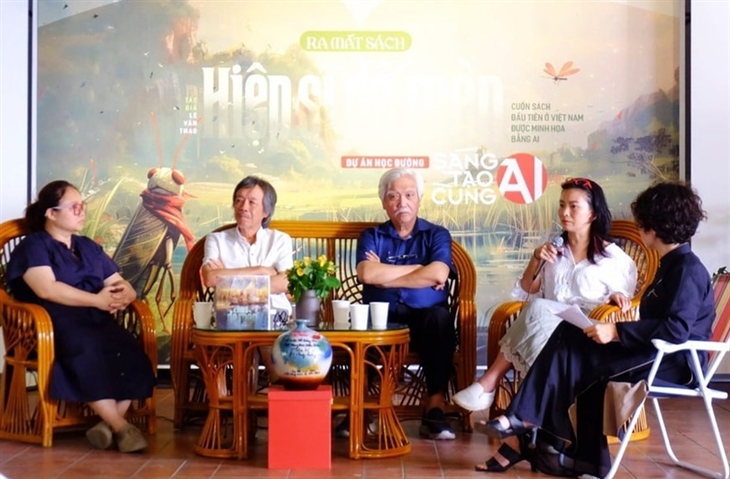Vietnam's textile and garment industry continued to grow in difficult times
Thursday, August 14,2025
AsemconnectVietnam - In the first 7 months of 2025 Vietnam's textile and garment exports reached more than 22 billion USD, up by 11% over the same period, ranking among the top 5 largest export industries in the country.
However, this growth momentum is still challenged by two major "bottlenecks": falling yarn prices and dependence on imported raw materials.
Transforming to increase value
The world textile and garment market is entering the final months of 2025 with a picture full of fluctuations and challenges. Competition is forecast to be fiercer than ever, as advantages between countries are increasingly "leveled" due to changes in trade policies of major import markets.
However, Vietnam's textile and garment industry is still showing remarkable stability, with export turnover in the first 7 months of 2025 reaching over 22 billion USD, up by 11% over the same period, ranking 5th out of 9 largest export industries in the country.
Despite positive signs, the industry still faces two major "bottlenecks" according to a report by THT Textile Corporation: falling yarn export prices and dependence on imported raw materials.
It is estimated that in 2025, Vietnam will import about 26 - 27 billion USD worth of raw materials, up 4 - 8% over the previous year. This not only makes it difficult for businesses to meet the origin requirements of free trade agreements to take advantage of tariff incentives, but also puts them at risk from price fluctuations and global supply chains.
Faced with these emerging issues, Vietnamese textile and garment enterprises are proactively seeking and implementing many strategic solutions to maintain and enhance their competitive position. Instead of continuing to compete on low prices, the Vietnamese textile and garment industry is being advised to focus on improving productivity and switching to producing high-value items. Products such as vests, winter coats, or swimwear, which have outstanding export unit prices, are becoming the focus to optimize business efficiency.
At the same time, changing the proportion of market structure, focusing on production and consumption for efficient items, as well as carefully analyzing costs and selling prices to determine the profit and loss of each item are key factors that help businesses make flexible production decisions and optimize profits.
One of the urgent and strategic solutions is to increase the localization of raw materials. This requires developing domestic supply chains, investing in domestic cotton and fiber production, especially sustainable cotton and recycled fibers. This move not only helps reduce dependence on imports but also better meets the requirements of origin and green standards from international markets.
In addition, applying wastewater treatment technology and reusing raw materials is also a prerequisite to meet the strict environmental standards of major markets.
The industry also encourages businesses to proactively participate in exhibitions such as Global Sourcing Fair Vietnam 2025 to learn from experience and connect with partners requiring sustainable standards.
Optimizing operations and technology
In the context of a volatile market, maintaining the stability of the workforce is considered a top priority. To do this, businesses need to constantly review and upgrade equipment to be ready to meet new orders, and regularly update and analyze market information to have timely and effective solutions.
A typical example of this initiative is 8/3 Textile Company Limited. In the first 7 months of 2025, 8/3 Textile achieved an output of 6,832 tonnes of yarn and revenue of 460 billion VND, completing about 50% of the annual plan, while maintaining an average income for workers at 13.2 million VND/person/month. This unit has drastically implemented solutions such as optimizing output, stabilizing and improving the quality of raw materials, and maintaining continuous production time.
At the same time, 8/3 Textile is also a pioneer in reducing production costs through saving electricity, regulating production to limit technology changes, comparing unit prices of equipment suppliers, and optimizing logistics costs.
An indispensable trend is the application of digital technology in design and production to optimize costs and improve product quality. This is considered an important step to help Vietnamese textile and garment enterprises overcome current obstacles and create sustainable competitive advantages in the future.
It can be seen that although the textile and garment market in the last months of 2025 is forecasted to continue to face many difficulties, the Vietnamese textile and garment industry is demonstrating high flexibility and adaptability.
With synchronous solutions from increasing product value, localizing raw materials, to optimizing costs and applying technology, the Vietnamese textile and garment industry is firmly on the journey to breakthrough and affirm its position on the global textile and garment map.
CK
Source: VITIC/ haiquanonline.com.vn
Vietnam boosts border trade with Cambodia
Vietnam’s July exports hit record of over 42 billion USD
Daily: Domestic pepper prices remained unchanged on August 12, 2025
Daily: Domestic rice prices increased by VND100 – 150/kg on August 12, 2025
Daily: Domestic coffee prices increased on August 12, 2025
Seafood industry aims for 10 billion USD in 2025
Ho Chi Minh City's imports and exports reached nearly 110 billion USD in 7 months
Trao đổi thương mại Việt Nam – Đức 6 tháng đầu năm 2025
Vietnam - Netherlands trade exchange in July and the first 7 months of 2025
Industrial production index increased in 34 localities in 7 months
Vietnam’s exports, imports and trade balance in first 7 months of 2025
Impacts of EVFTA on Vietnam – Netherlands trade
Expanding ‘rice road’ to the world
Reducing costs from source creates export advantages for Vietnamese agricultural products

Plan of Hai Duong province for a period of 2021 - 2030, ...
Organize space reasonably and harmoniously, focusing on connecting Hai Duong in common development space, actively contributing to the ...Plan of Hau Giang province in a period of 2021 - 2030, ...
Sustainable forestry development program in a period of ...

AI opens new path for image industry: Insiders
Though the term "image industry" remains relatively new in the local context, the development of a creative ecosystem driven by AI will ...Hanoi’s street food culture gains ground with Michelin nods
Draw held for 2025 Davis Cup Asia/Oceania Group III in Bac ...
Da Nang Museum opens an exhibition of rare ancient ...
An Giang races to complete UNESCO nomination dossier for ...



